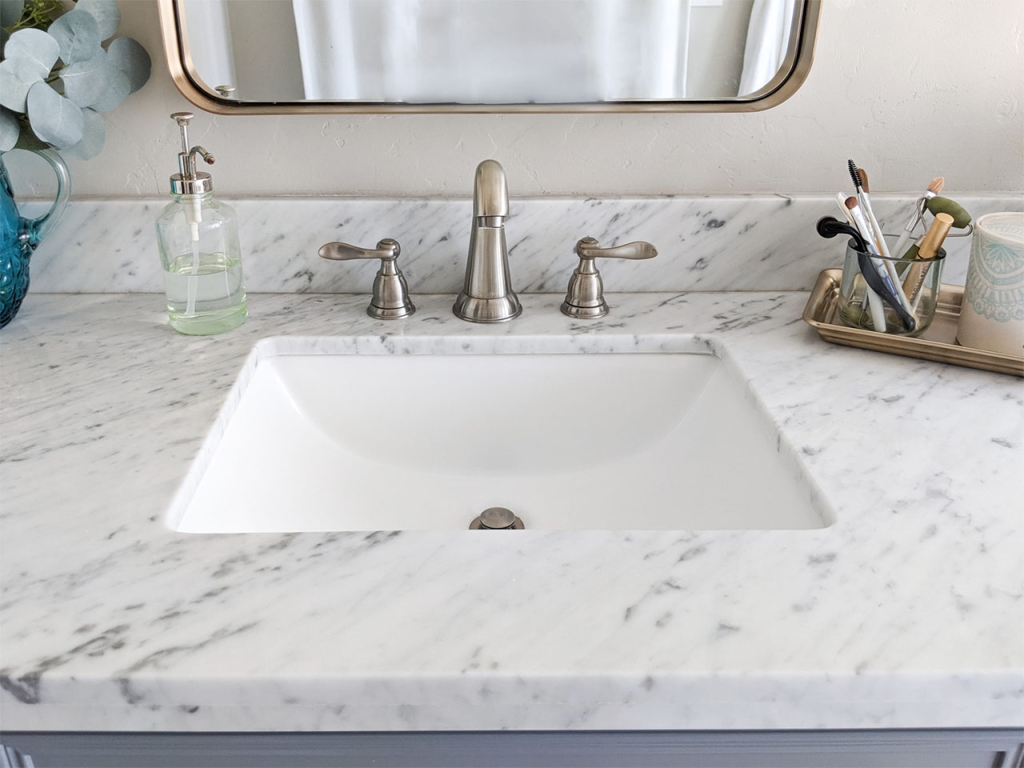If you’re planning to upgrade your kitchen, chances are you’ve come across the term “under mount sink.” This modern sink type has made waves in kitchen design for its clean lines and functionality. But before you make a purchase, there are a few key things you need to know. Let’s dive into the six most important things you should consider when choosing an undermount kitchen sink.

1. What Is an Undermount Kitchen Sink?
An undermount kitchen sink is installed beneath the countertop rather than resting on top of it, as with traditional drop-in sinks. The result is a sleek and seamless look that allows the countertop to flow uninterrupted into the sink. Without the rim that a drop-in sink has, undermount sinks make wiping food or liquids directly into the sink much easier.
The installation involves securing the sink to the bottom of the countertop, often with adhesive and support brackets. It’s important to note that undermount sinks require a solid and stable countertop material, such as granite or quartz, for proper installation and support.
2. Pros of Undermount Kitchen Sinks
Undermount sinks come with a host of benefits that make them highly sought after in modern kitchen designs:
Seamless Design
The absence of a raised rim gives the kitchen a more streamlined and minimalist appearance. It creates a smooth transition between the granite countertop and sink, which looks sophisticated and clean.
Easy to Clean
One of the biggest perks is the ease of cleaning. With no lip to catch crumbs or spills, you can simply wipe debris from the counter directly into the sink. This makes kitchen clean-up a breeze.
More Counter Space
Since the sink is installed underneath the counter, you gain extra inches of usable space on top. This is especially useful for small kitchens where maximizing every inch is critical.
3. Cons of Undermount Kitchen Sinks
While undermount sinks have clear advantages, they also have a few downsides worth noting:
Installation Challenges
Installing an undermount sink is more complex than installing a traditional drop-in sink. It requires precision, especially when cutting the countertop and securing the sink underneath. It’s generally recommended to have a professional handle the installation.
Higher Cost
The sleek design of undermount sinks comes with a higher price tag, both for the sink itself and the installation. Custom-cut countertops and expert labor can increase the overall cost.
Limited Countertop Compatibility
Undermount sinks work best with solid surfaces like granite, quartz, or marble. Laminated or tiled countertops may not be strong enough to support the weight of the sink, limiting your options.
4. Types of Materials for Undermount Kitchen Sinks
Choosing the right material for your sink is just as important as the sink type. Here are the most common materials used for undermount sinks:
Stainless Steel
Stainless steel is the most popular material due to its affordability, durability, and modern look. It’s also easy to clean and resistant to corrosion.
Porcelain
Porcelain undermount sinks are classic and elegant. They are available in a variety of colors but are more prone to chipping and staining compared to other materials.
Granite Composite
Granite composite sinks are made from a blend of granite stone and resin, offering high durability and resistance to scratches and stains. They are heavier than stainless steel but give the kitchen a high-end, luxurious feel.
5. Cost of Installing an Undermount Kitchen Sink
The cost of an undermount sink varies depending on the size, material, and complexity of the installation. On average, undermount sinks can range from $200 to $500 for the sink itself, with installation costs adding another $200 to $700, depending on labor and countertop modifications. These sinks are generally more expensive than drop-in sinks, but many homeowners find the aesthetic and practical benefits worth the investment.
6. Maintenance Tips for Undermount Sinks
Like any sink, proper maintenance is crucial to ensure longevity. Here are some tips to keep your undermount sink in great shape:
Regular Cleaning
Regularly clean your sink with a non-abrasive cleaner to avoid scratching the surface. Stainless steel sinks benefit from routine polishing to keep them looking shiny.
Preventing Leaks
Since undermount sinks are installed underneath the countertop, there’s a chance for leaks if the seal between the sink and the counter isn’t maintained. Ensure the seal is checked periodically and re-caulked if necessary.
Handling Stains and Scratches
Different materials require different care. For instance, avoid harsh chemicals on granite composite sinks, and use gentle sponges on porcelain to avoid chips or scratches.
Conclusion
Undermount kitchen sinks are an excellent choice for homeowners looking to combine style with functionality. Their sleek, modern design and easy maintenance make them a top choice for contemporary kitchens. However, their installation requires careful planning and possibly professional help. Knowing what to expect, from material choices to cost and maintenance, will ensure you make the right decision for your kitchen.
FAQs
1. Can I install an under mount sink myself?
While it’s possible to install an undermount sink yourself, it requires precision and specialized tools. Most homeowners opt for professional installation to avoid potential issues like leaks.
2. Are under-mount sinks more prone to leaks?
Under-mount sinks can be more prone to leaks if not installed correctly due to the caulking between the sink and countertop. Regularly checking and maintaining the seal will prevent leaks.
3. What is the best material for an undermount sink?
Stainless steel is the most popular due to its affordability and durability. Granite composite is another excellent choice for those wanting a premium, scratch-resistant option.
4. How often do under-mount sinks need to be replaced?
A well-maintained under-mount sink can last for decades. However, if the seal deteriorates or the material becomes damaged, repairs or replacement may be necessary.
5. Is it worth spending more on an undermount sink?
Yes, if you value a seamless design, easy cleaning, and a modern aesthetic. The higher cost may be justified by its enhanced look and functionality in your kitchen.

